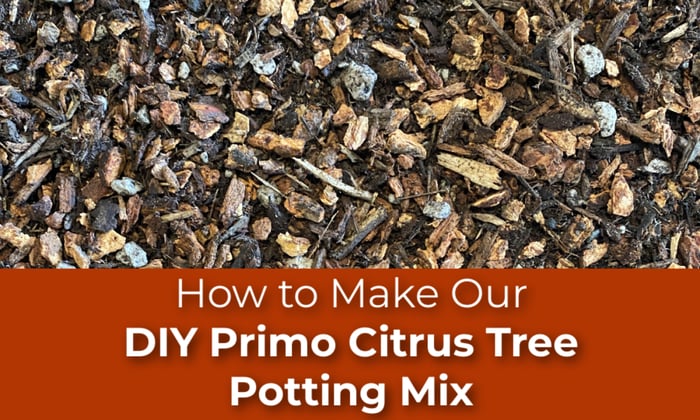Growing Citrus in Containers
Citrus trees are especially suited for container growing as they can be kept at manageable sizes. Growing citrus in containers allows gardeners to overcome poor soil conditions or limited space in a landscape. People enjoy their trees in decorative pots on a patio or apartment balcony. Many growers have cold winters and bring their citrus indoors during freezing weather. These tips can help you on the way to successful citrus growing in containers.
If the adventure of growing citrus in containers feels daunting you can start slowly with one of these three “easiest to grow” trees: Meyer Lemon, Calamansi or Bearss Lime.
For our more experienced growers, all of your favorite Oranges, Mandarins, Lemons, Limes, Kumquats, and Grapefruits will grow wonderfully in a container. Grafted semi-dwarf citrus trees can reach 6-10 feet tall in containers, but pruning will keep them more compact if you'd like a smaller tree.
Selecting Planting Containers
For growing citrus in containers, we recommend a 10-14", or 3-Gallon pot for starter sized Primo trees. Our 5- Gallon trees can be repotted into 10-gallon pots. When selecting a container, be sure there are sufficient drainage holes. Drilling extra holes is an easy way to improve drainage with wood or plastic. As the Primo sized tree tree grows, increase the container size to a 16-20" diameter pot (the next pot size up). Do not start with a pot that is too large as it makes soil moisture levels harder to control with small trees. The root structure should nearly fill lout the space within the pot. Too much extra soil tends to stay wet for too long and that can cause the roots to deteriorate. (Also called "root rot" or "wet feet")
Selecting a Location for Outdoor Containers
When it comes to growing citrus in containers outside, provide 6-8 hours of direct sunlight per day. More is better, but there is such a thing as too much direct sun. On long, hot summer days, you may have to move your tree to an area that gets some afternoon shade. Citrus are understory trees, so there is a balance between too much and not enough sun every day. Our grandfather would say plant your citrus tree in the spot where a cat would nap. Sunny, wind-free locations with southern exposure are the best. If in doubt, leave the tree in its plastic container and place it in the spot you have in mind. After a week or two, you should be able to tell whether or not it is thriving. Reflected heat from sidewalks or houses can also help to create a warmer microclimate. Avoid placing citrus in containers on or near lawns that get frequent, shallow watering. To reduce excessive heat on the roots, try nesting plain plastic nursery pots into slightly larger decorative pots. Another option is to elevate it on bricks or cement block with some airflow underneath. This can help roots stay cooler.
Protecting young trees and tender new growth from the scalding sun is an important step to take for growers in warmer climates or with particularly hot yards. Plant Guard tree paint and foliar spray is a great organic product and is highly recommended for those who want an easy-to-apply layer of protection.
Be sure the pot never sits in standing drainage water. If you must use a saucer, some river rocks placed in the saucer is one of the better ways to ensure adequate drainage.
Growing Citrus in Containers- Indoors
If your winters regularly drop well below 32°F (typically zones 4-7), then your citrus tree will have to live indoors during the winter months. Ideally, this is after your tree has spent the spring, summer and some of fall outdoors. Transitioning your tree inside slowly is crucial so that the tree does not go into shock. Signs of shock would be wilting leaves, yellow leaves, and dropping its leaves, flowers and/or fruit.
Indoors, try as much as possible to replicate the conditions as if it's a lovely fall day and winter doesn't even exist in your lemon tree's world. In your lemon tree's world, the days don't get shorter, the weather stays cool and not too cold, and the air has a lovely- some would say, tropical vibe going on. This is where some grow lights, a humidifier and a sunny spot away from drafts comes in. Freezing weather... what's that? We must never let the lemon tree know about it.
Here is a great PDF Guide and Indoor Citrus Growing Blog to walk you through the steps if indoor growing is your destiny. Once the W-Word has passed and spring comes dancing in, your tree can be let back outside, slowly and gently. We have a guide to help you get started: how to transition your citrus tree outdoors here.
Selecting a Soil Mix for Container Planting
We recommend using a commercially available citrus potting mix like our Primo Potting Mix or making our 5-1-1 mix. This mix consists of 5 parts fine bark (aim for 1/2" pieces), 1 part perlite, and one part potting soil. This mix will break down very slowly, allow for adequate drainage, promote healthy root growth. Using dirt (native soil from your yard) in a container is not advisable. We also advise against putting gravel or any other material on the bottom of the pot, as this negatively impacts drainage over time.
The perfect high porosity soil mix can be hard to find. Pine and spruce shavings tend to break down more quickly, so are not ideal. Try to select hardwood chips that will last longer. If necessary, moisten the mix to reduce dust and make it easier to handle.
Use a soil mix that is lightweight and drains well. If the mix contains a large proportion of dense, absorbent material, such as peat moss or worm castings, amend with 1/4-1/3 volume of 1" cedar or redwood shavings. Water in thoroughly, using Vitamin B-1 rooting tonic in the first few applications, if desired. Once the roots have settled, we prefer using slow-release fertilizers applied to the soil surface, rather than mixing fertilizer into the soil or using plant stakes. This avoids any risk of burning the roots. Romeo Plant Food is what we recommend and use at the nursery, and has proven to do extremely well for growing citrus in containers. Apply monthly during the growing seasons- spring, summer and early fall. You do not need to feed your tree during the winter months.
When shopping for the perfect citrus soil mix, please avoid those that contain chemical wetting agents or fertilizers. Soil mixes formulated for outdoor use are preferable to potting mixes for indoor plants, since the latter often contain chemical wetting agents, causing tree roots to remain too wet after watering. You can start with a good rich organic soil and amend with about 1/3-1/2 volume shavings, perlite, or coco fiber. Mixes for Cactus/Citrus have a lot of sand but can work. Use your judgment to amend as needed.
Planting in Containers
Once your soil mix is prepared, your container is selected, and the tree's eventual location is known, you are ready to begin potting your tree.
Place prepared soil mix in the bottom of your new container, about 1/4 of the way up. Gently slide tree roots out of the old container and shake off the old soil so that the roots will have access to the new soil mix. Use your fingers to spead the roots, but be careful not to break them off. It is much easier to repot a tree that has a slightly moist, not super dry, root system. Place the loosened root mass into the new container and gently fill with your fresh planting mix, packing down lightly to remove large air spaces from the root zone. You can gently shake around the tree within the pot to settle it in and make sure it centered and straight. The top of the roots should be just beneath the soil surface, and crown roots (root collar area) should show above the soil line. Make sure that soil or mulch is not pushed up against the trunk of the tree. Water deeply two times in a row. Stake loosely with a green tie if needed. The stake should be at least 2-3" away from the trunk of the tree. It’s a good idea to re-pot your young tree every year or so or if you notice that the soil level has gone down a few inches and the crown of your roots are exposed.
Watering in Containers
Consistency is the key to citrus watering. Much like having pets, citrus trees like to know that they're going to be routinely "fed" (with water) at around the same time. Determining how often depends on the weather, and how quickly your tree drinks the water and the soil dries out. Citrus trees require soil that is moist but never soggy. Develop a watering schedule so the roots maintain even moisture, but are not waterlogged.
Watering frequency will vary with soil porosity, tree size, and environmental factors. Generally, once or twice a week deep watering works well for container trees. It is best to water in the morning, but if plants are dry or wilted it is better to water them right away than wait until morning. Elevate pots above standing drainage water.
Water before leaves show wilting, and when roots have reached about 50% dryness. Check the moisture level in the soil by sticking your finger 2" down into the soil feeling for wetness. If it's dry or barely moist, then you know it's time to water. A wilted tree that perks up within 24 hours after watering indicates the roots got too dry. You will have to adjust the watering schedule accordingly. A tree with yellow, cupped, or leaves that don't look perky after watering can indicate excessive watering and soggy roots. You may have your tree water less often.
A moisture tester can be an excellent tool to help determine when roots are in need of a drink. Because most commercial moisture testers rely on an electrical conductivity method, however, it is possible to get a misreading due to high salinity or other conditions. An alternative method recently shared by a New England citrus enthusiast simply employs a plain wooden dowel about the diameter of a pencil. Sharpen it with a whittling method (sharp knife) or pencil sharpener. Then insert this into the pot at varying depths, shallow to deeper, determining moisture using your direct senses (feel, smell, etc.).
As the previous example of an alternative moisture tester shows, growing citrus in containers inspires innovation! People over the years and in every state have experimented, using locally available materials and resources to develop methods that work for them.
Short & Sweet Version: The goal with growing citrus in containers is to provide the same conditions that the trees thrive in when planted in the ground. These conditions include well-draining soil, full sun, regular feeding, infrequent deep watering, and protection from extreme conditions/pests.
Check out our Citrus Growing Tips for more information about growing citrus in containers or in the ground.
Also read: How to Prune Your Citrus Trees
Get in the know about HLB(Huanglongbing / Citrus Greening Disease) and help save your community's citrus. Only source citrus trees from reputable growers.




